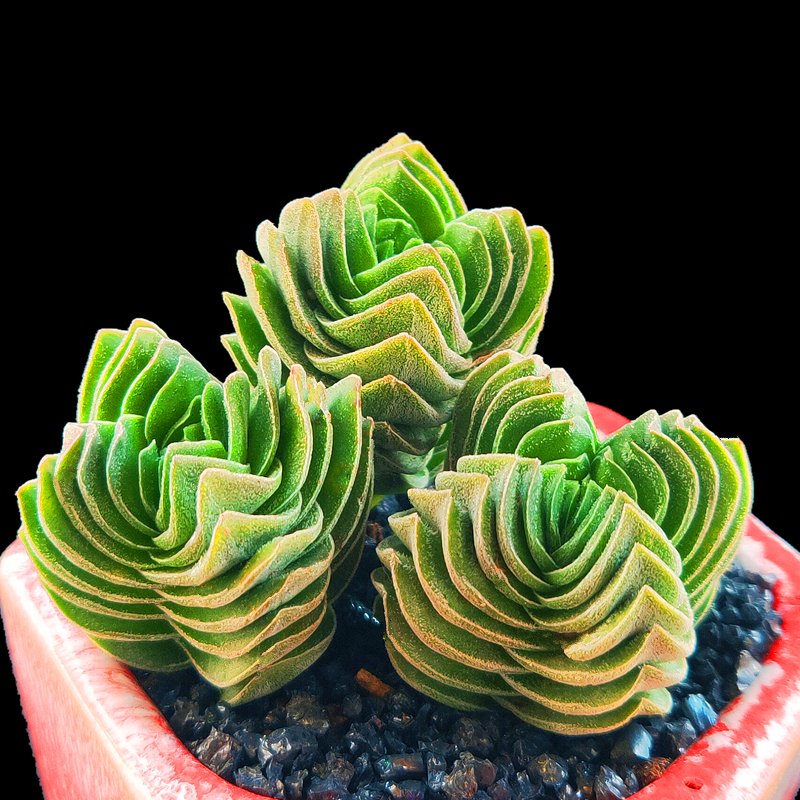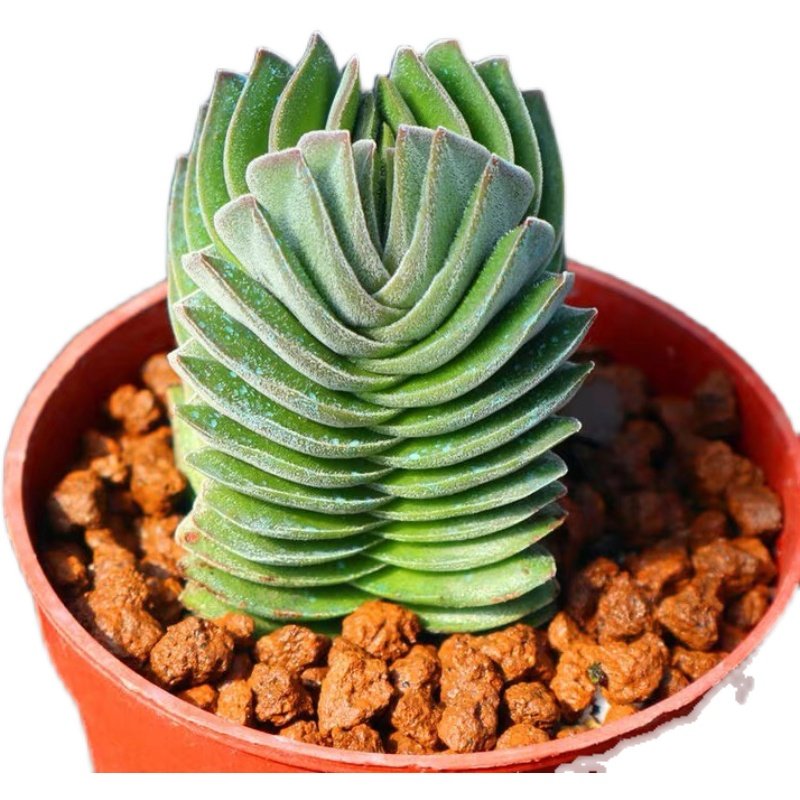
You will always notice the bold shape of crassula cv. buddha’s temple. This plant stacks its leaves to look like a small tower. The tower shape looks like a pagoda. Its shape is easy to spot right away. Each leaf makes a neat and even layer. The layers are very even and catch your eye. Collectors like crassula cv. buddha’s temple for its special look. It also needs careful care. The temple shape and buddha’s style make this plant different from other succulents.
Key Takeaways
- Crassula cv. Buddha’s Temple has a special square tower shape. Its leaves are stacked neatly and look like a small temple or pagoda.
- The plant grows slowly and straight up. This makes it rare and great for small spaces or apartments.
- Its silvery-gray leaves have a powdery layer. This layer protects the plant and makes it look fancy.
- This succulent needs bright light and soil that drains well. These things help it keep its small shape and soft colors.
- It is hard to make new plants from Buddha’s Temple. It also grows slowly. That is why collectors think it is special and rare.
Unique Structure of Crassula cv. Buddha’s Temple

Leaf Arrangement
When you look at crassula cv. buddha’s temple, you see a plant that builds itself like a beautiful square-shaped tower. The leaves stack tightly in sets of four, creating a compact, square column. Each leaf is thick and heart-shaped or sometimes looks triangular. These leaves overlap each other, forming layers that remind you of a pagoda or temple roof. The edges of the leaves line up so neatly that the plant almost looks like it was built by hand. If you look from above, you notice a cross-shaped pattern. This special arrangement helps the plant save water and protect itself from the sun. The silvery-grey color and powdery surface on the leaves also help keep the plant healthy in bright light.
Tip: If you want to see the unique leaf pattern, try viewing crassula cv. buddha’s temple from different angles. The stacked leaves create new shapes as you move around the plant.
Shape and Symmetry
You will find that crassula cv. buddha’s temple stands out because of its perfect symmetry. The plant follows natural patterns found in math, like the golden ratio and Fibonacci sequence. These patterns help the plant grow in a way that looks balanced and pleasing to the eye. The leaves spiral upward, forming a tower that looks both natural and designed. This symmetry is not random. It comes from the way many plants grow, but crassula buddha’s temple shows it in a very clear way. The geometric form makes it look like a tiny temple or pagoda, which is why collectors love it.
- The plant’s symmetry makes it easy to spot in any collection.
- The upward-facing leaves add to the temple-like effect and help the plant catch light.
Growth Habit
Crassula cv. buddha’s temple grows slowly and vertically. You will see the plant build its tower over time, adding new layers as it grows. The compact, vertical growth habit makes the plant look like a small sculpture. This slow growth is one reason why the plant is rare and special. The stacked, pagoda-like leaves form a multi-tiered structure that you do not see in most other crassula plants. Because it grows slowly and keeps a tight shape, it stays small and neat for a long time. This makes it a favorite for people who want a unique plant that does not take up much space.
Note: The rare growth habit and temple shape make crassula cv. buddha’s temple a prized plant for collectors. Its beautiful square-shaped tower and upward-facing leaves set it apart from other succulents.
Color and Texture
Leaf Colors
You will notice that Crassula cv. Buddha’s Temple shows off a unique color palette. Most of the time, the leaves appear silver-gray or gray-green. These cool tones give the plant a calm and elegant look. Sometimes, you might spot hints of yellow, pink, or even red along the edges of the leaves. These colors do not appear all the time. They show up when the plant faces stress, such as strong sunlight or changes in its environment.
- The plant prefers bright light and dry air.
- If you give it 3-4 hours of full sun, the leaves keep their compact shape and subtle colors.
- When the plant gets less sunlight, it may stretch out, but the leaf color stays mostly the same.
- You might see brighter edges if the plant feels a little stressed, but the main color remains gray-green or silver-gray.
This color stability makes the plant easy to recognize. The soft shades help it stand out among other succulents.
Surface Qualities
When you touch the leaves, you will feel a thick, fleshy surface. The leaves often have a powdery layer, called a “bloom.” This layer looks like a soft, silvery dust. It helps protect the plant from too much sun and keeps water inside the leaves. Sometimes, the leaves look glossy instead of powdery. Both textures add to the plant’s beauty.
Tip: The powdery layer can rub off if you touch the leaves too much. Try to handle the plant gently to keep its natural look.
The mix of color and texture gives Crassula cv. Buddha’s Temple a special charm. The plant’s surface catches the light in different ways, making it look almost magical on a sunny day.
Rare Features of Crassula Buddha’s Temple
Slow Growth
You will notice that crassula cv. buddha’s temple grows very slowly. The plant adds new layers one by one, building its tower shape over many months or even years. This slow, vertical growth makes each plant unique and special. You will not see it change quickly like some other succulents. The compact form stays neat and tidy, which helps the plant keep its temple-like look for a long time. Because of this slow pace, you will find that mature plants are rare and often more valuable to collectors.
Limited Availability
You may wonder why crassula buddha’s temple is hard to find in stores or nurseries. The answer comes from the challenges in propagation. Most growers find it difficult to produce new plants. Here are some reasons:
- Propagation from seeds takes a long time and does not always work.
- Leaf propagation almost never succeeds. The leaves are thin and fragile, so they do not have enough energy to grow new shoots or roots.
- Only one known case of successful leaf propagation exists.
- The best way to make new plants is by using buds or clippings. Even then, you must handle them with care to help them root.
Because of these challenges, you will see high demand from collectors. People want to own this rare plant, but growers cannot produce many at once. This limited supply makes crassula cv. buddha’s temple even more special.
Flowering
You might hope to see flowers on your crassula cv. buddha’s temple, but flowering is very rare when you grow it indoors. In the wild, the plant can bloom, but as a houseplant, it almost never does. If you are lucky enough to see it flower, you will notice small, star-shaped blooms at the top of the stems. These flowers appear in clusters and show soft shades of white or pale pink. They usually bloom in late spring or summer. The delicate flowers add a gentle contrast to the plant’s strong, architectural form.
Note: The rare flowers make this plant even more prized among collectors. If your plant blooms, you have witnessed something truly special.
Crassula Comparison and Display

Other Crassula Varieties
When you look at different crassula plants, you will see many shapes and sizes. Some, like Crassula ovata (jade plant), have round, glossy leaves and grow as small trees. Others, such as Crassula perforata (string of buttons), show stacked, triangular leaves that spiral along the stem. Most crassula species spread out or grow in loose clusters.
Buddha’s Temple stands out because of its tight, square column and perfect symmetry. You will not find another crassula with such a precise, pagoda-like form. The leaves stack in neat layers, making the plant look like a tiny building. This structure is rare among succulents. Many collectors search for Buddha’s Temple because it is hard to find and grows slowly. Other crassula plants may be easier to grow or more common, but they do not have the same architectural beauty.
Tip: If you want a plant that looks like a living sculpture, Buddha’s Temple is a unique choice among crassula varieties.
Decorative Value
You can use this succulent as a centerpiece in your collection. Its compact size and geometric shape draw attention right away. Place it near a bright window or under a grow light to keep its temple-like form. If you use a small pot with drainage holes and well-draining soil, you help the plant stay healthy. Many people add stones on top of the soil to keep moisture balanced and make the display look even better.
Here are some ways to display your plant for the best effect:
- Place it on a sunny windowsill or balcony.
- Use a small, decorative pot to highlight its shape.
- Group it with other succulents for contrast.
- Show it alone as a single, eye-catching specimen.
The plant’s layered leaves and silver-gray color make it look elegant in any setting. You will find that proper care, like letting the soil dry out between waterings, helps keep its unique form. Because of its rare structure and beauty, Buddha’s Temple often becomes the star of any succulent display.
You can see why collectors value this plant. The square column of stacked, silvery leaves looks like a tiny temple and draws attention in any collection. You will notice the rare pink or white star-shaped flowers in summer, which add even more beauty. Many people want this plant because it is a rare hybrid and hard to find. Proper care helps you keep its unique shape and color. If you enjoy plants with architectural beauty, this one stands out among succulents.
FAQ
What makes the appearance of Buddha’s Temple so unique?
You see a beautiful square-shaped tower with upward-facing leaves. The leaves stack in neat layers, giving the plant a temple look. This geometric shape stands out among any succulent collection.
Is Buddha’s Temple an ideal plant for apartments?
Yes, you can keep this succulent in small spaces. Its compact size and slow growth make it an ideal plant for apartments. You do not need much room to enjoy its unique tower form.
How much care does Buddha’s Temple need?
You will find this plant low maintenance. Give it bright light and let the soil dry between waterings. Avoid touching the leaves too much to keep the powdery surface. With simple care, the temple shape stays healthy.
Why do collectors value Buddha’s Temple?
Collectors love the rare structure and slow growth. The plant’s beautiful square-shaped tower and upward-facing leaves make it special. Its limited availability and unique appearance add to its value.